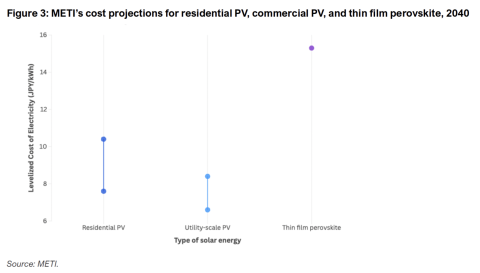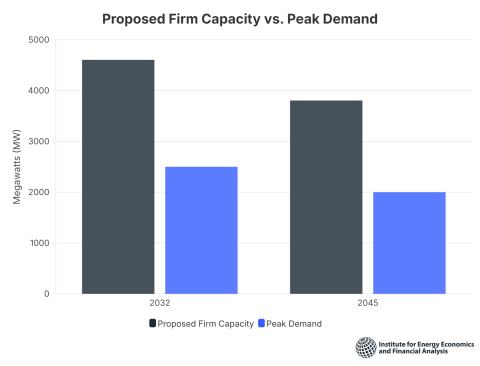Opportunity for a new direction for Puerto Rico’s electric system
Download Full Report
Key Findings
In July 2015, PREPA released an Integrated Resource Plan laying out how it proposes transitioning the electricity system of Puerto Rico over the next two decades. The plan was the first integrated resource plan ever produced by PREPA, and came about as a requirement of an energy reform law passed in 2014.
PREPA runs the risk of cost overruns and construction delays in constructing the Aguirre Offshore Gas Port, which would result, in turn, in delays and higher costs in converting its power plants to natural gas, costs that ultimately would be paid by PREPA customers.
Even a relatively small increase in natural gas prices or shipping prices above the forecast would have significant financial implications for PREPA. By 2030, under its preferred scenario, Puerto Rico will be spending more than $1 billion a year on imported natural gas. Thus, even a 10% increase in the price of natural gas or in its shipping costs would cost the island over a $100 million annually.
Executive Summary
Puerto Rico’s electricity system is in need of transformation. The Puerto Rico Electric Power Authority (PREPA), the public agency that runs the island’s electrical system, is more than $8 billion in debt and struggling to pay its creditors. PREPA’s financial problems are due to a combination of factors that include rates that do not cover the cost of generating power, an inefficient system of subsidized electricity, and a high level of electricity theft.
In addition to its financial problems, PREPA is hobbled by an old, expensive and heavily polluting power system. More than half of the island’s electricity—the vast majority of which is generated by PREPA—comes from oil-fired power plants. It is likely that as a result of the U.S. Environmental Protection Agency’s Mercury and Air Toxics Standard (MATS), PREPA will retire or curtail the operation of most of its oil-fired units. Therefore, PREPA is planning major investments in its generation system over the next decade. PREPA’s “preferred path” calls for the utility to replace its over-dependence on oil with over-dependence on natural gas.
PREPA is thus facing a two-fold, intertwined challenge: energy and financial. PREPA will not be able to make the necessary investments in its generation system unless it is able to resolve its debt crisis.
In Part 1 of the report, we highlight the peril of transitioning Puerto Rico’s electrical system from one based largely on one fossil fuel—oil—to one based on another—natural gas. One result would be that Puerto Rico would divert more than $1 billion per year from its fragile economy just to pay for fuel, even though the island is blessed with abundant wind and solar energy. We note that PREPA’s record on energy efficiency has been terrible, ranking last among states and U.S. territories. We note also that Puerto Rico has largely failed to prioritize development of its wind and solar resources. Puerto Rico does not rank among the top 10 states in terms of installed solar capacity per capita. And PREPA has not seriously evaluated an energy system transformation that would turn heavily on wind, solar and energy efficiency, even though all three resources are highly costcompetitive in Puerto Rico. Puerto Rico ranks 33rd among U.S. states and territories for wind energy.
We make three energy-reform recommendations:
- That Puerto Rico pursue a clean-energy transformation from its current over-reliance on expensive and outdated oil-fired power plants.
- PREPA should not lock into an investment path that would make the island overly reliant on natural gas.
- That PREPA adopt an integrated resource plan that includes a scenario prioritizing investment in wind, solar and energy efficiency.
Part 2 of the report relates to PREPA and the broader Puerto Rican debt crisis. On Sept. 2, PREPA released a tentative debt-relief plan that it negotiated with a portion of its bondholders. PREPA has disclosed that the plan would provide for an 85% exchange rate on a portion of PREPA’s indebtedness, that is, bondholders would receive 85% of principal.
A complete analysis of the debt deal is not yet possible because not all of the terms have been disclosed. Transparency is in the public interest, and public disclosure of the status of these negotiations should be required alongside additional approvals needed to complete this transaction.
Based on the information that has been made public, IEEFA makes the following recommendations for next steps in the debt-restructuring process:
- That PREPA make additional efforts in the coming weeks to secure deeper principal reductions from bondholders, particularly large institutional investors, hedge funds, and insurance companies in order to provide itself greater financial flexibility.
- That PREPA acknowledge the proposed 85% level of bond recovery is too generous to bondholders and will undermine PREPA’s efforts at long-term financial reform and frustrate investment in new energy resources.
- That whatever debt improvements PREPA ultimately makes be used to make room for prudent investments in solar energy, wind energy, and energy efficiency and not for an increase in the agency’s reliance on natural gas.
- That the final deal include plans to reduce PREPA’s high electric rates so as to protect ratepayers and avoid undermining Puerto Rico’s future.
A new debt agreement for PREPA could provide the agency with crucial financial flexibility and a timely platform to launch a new energy plan for Puerto Rico.
Please view full report PDF for references and sources.
















